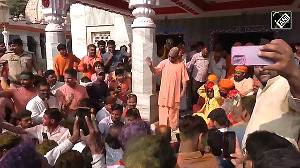On Diwali, the Kanchi Shankaracharya, Jayendra Saraswathi, was arrested on charges of murder. On the next day, the title of an article in a national daily read 'Seer heads 5,000 crore empire. Another article in a leading national newspaper read, 'Of high priests and their lust for more power.' He has been variously described as high profile, influential and the seventh most powerful man in India.
The Shankaracharya is in custody, the police are on a wild evidence hunt, and the media is marauding a large cut of the spoils. The seer's high profile status has somehow been conveniently used to imply that he is a goon-wielding, power kooky tycoon. The assets of the Kanchi Math are being referred to as if they were the acharya's personal possessions, and every one of his past actions is being interpreted according to the revised image that the press has decided to give him.
| |||||||||||
As a 19-year-old boy, he stood in hip-deep waters and embraced asceticism, pledging detachment from every material pursuit. Ever since, he has eaten minimally for subsistence, not slept on a comfortable bed and not indulged in any sensual pleasure. He has no next of kin; he severed ties even with his parents. Austerity in the absolute sense. For more than 50 years, he has lived such a life in complete public view. He is a scholar of wide attainments and great versatility who has mastered the Rig Veda, the Dharma shastras, the Upanishads under all the Veda Shakas, Vyakarana, Vedanta, Nyaya and Tarka shastras through the course of his life.
All the articles that holler about the 'high profile' pontiff do not devote any newsprint to how he has utilised his position of authority. Jayendra Saraswathi, after taking over as the Shankaracharya, is singularly responsible for opening 55 schools and a string of hospitals, professional colleges, child care centres and universities throughout the country. The services in these institutions are offered free of charge or at subsidised rates, and benefit large sections of society. In addition, charitable trusts for aiding poor families, old-age homes, rural development trusts, food donation projects, and research projects have also been flagged off by the acharya. Although the seer is perceived as a Hindu Brahmin icon, the condemnation of his arrest by the Muslim and Christian clergy is a comforting testimony to the tolerant, secular face of Hinduism that he has presented in crises.
The Shankaracharya wears saffron according to the canon prescribed for a sanyasi, thereby giving the media and the literati, an easy stereotype. So, the Shankaracharya gets pigeonholed with the paan-chewing, debauched politician who views the ochre as lucre. Hinduism's lack of rigidity does not prevent all and sundry from donning saffron. What is unfortunate is that we are not able to distinguish between a genuine ascetic and a masquerader.
For the most poignant players in this drama, the followers of the acharya, these are nightmarish times. Within a matter of hours, a man, who for many years, had graced their puja with the Gods, had been disgraced. The episode itself, with the unceremonious arrest of the venerable religious leader on an auspicious day, after a yagna, by commandos, was a rude jolt.
To exacerbate the wounds, the acharya, a 70-year-old diabetic, was held in custody for the outrageous reason that he would abscond to Nepal. He was not allowed to cook his own food, despite his religious caveats that prohibit food from outside, since it was alleged that he would attempt suicide. He was denied transfer to a hospital or house, unlike most high profile captives. His bail application was adjourned and he was remanded to judicial custody.
To the followers who have seen the Shankaracharya in all his glory, the image of an old man with failing health, drinking ragi porridge given to prisoners, and performing pujas in a cell, is heart-rending. Yet, unlike any other community in the world that can speak up when it is hurt, they find themselves mute. Before they could feel the impact of the shock, the VHP and the rest of the Hindutva brigade were already well on their way to politicising the issue and promoting party agendas. Worse yet, due to their public perception as extremist troublemakers, the support of these parties in this issue is a liability for the followers of the acharya.
For them, this intensely personal moment of distress does not have a sounding board. The denigration of one of the last bastions of their faith has left them disoriented, victimised and hurt. Their grievances will never get print footage, as they will be viewed with saffron coloured glasses and quickly branded as 'right wing' or 'fundamentalist.' Since their cause is not as fashionable as those of large dam project victims, people of alternate sexuality or people in another country's war, they are media-untouchables.
The overriding concerns in this issue are its actual intent and impact. The arrest of a religious leader is unprecedented. If the seer is proven guilty, the law will take its course of action as it rightfully should, for every citizen. However, speculation is rife on the political machinations and the frame-and-blame-game in the case. If the seer is proven not guilty, then where do we go from here? If this case is a political conspiracy, what is to become of the millions of devotees of the man? Do the politicians enmeshed in the throes of the immediate, understand the cultural and moral impact of this issue, and the possible damage that they have done?
In the smutty power and revenge match between individuals, along with the arrested seer, a 2,500-year-old institution has also been sullied, an institution that has stood the test of time, of cultural invasions and of religious warfare. The Shankaracharya is not a person, but a sacrosanct position of eminence in people's minds. After this episode, irrespective of its outcome, will the devotee still feel the sanctity of this position and this institution? Will he not feel demoralised and despondent about his faith, against the overwhelming backdrop of scepticism? Will millions of our citizens, with a beaten spirit, be able to place credence and hope in a leader again?
Shobha Vasudevan is a PhD student at the University of Texas at Austin






 © 2025
© 2025